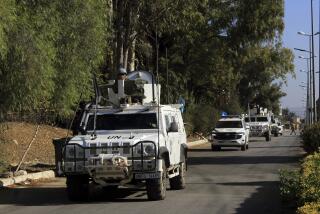U.N. Relief Efforts in Somalia
The prevailing situation in Somalia is too serious and tragic for any interested party to seek to defend its response as adequate or beyond reproach. The mere fact that 500 to 1,000 people--mostly children--are dying each day shows that for all the difficulties the relief effort has been too little and too late, as well as too ill-planned and inadequately coordinated.
This said, regarding the column written by Rakiya Omaar and Alex de Waal (“U.N. Agencies Are Incompetent,” Aug. 26), a number of the statements made with respect to the involvement of the United Nations and UNICEF in Somalia are seriously wrong and misleading.
The U.N., including UNICEF, has in fact maintained a presence in Somalia throughout most of the 4 1/2 years of the current conflict. This was achieved in a very dangerous security situation and at the cost of the lives of a number of U.N. staff including UNICEF staff. The authors’ attacks focus primarily on the absence of the U.N. in Mogadishu and conveniently neglect to detail the work of the U.N. in other parts of Somalia during the war. While it is true that the U.N. withdrew from Mogadishu in January, 1991, following the overthrow of Siad Barre, the authors forget to note that the U.N. withdrew along with the entire diplomatic staff and the overwhelming majority of the international aid community.
Although the U.N. was absent from Mogadishu for most of 1991, U.N. activities in other parts of the country continued. In addition, UNICEF along with other U.N. agencies continued to field relief teams and assessment missions into Mogadishu throughout the period. UNICEF also financed a monthly relief flight into Mogadishu to support the work of the few remaining NGOs (non-governmental organizations) and local Somali activities.
UNICEF reopened an office in Mogadishu in December, 1991, and has currently over 40 staff in Somalia in Mogadishu, Hargeisa, Berbera, Kismayo, Baidoa, Badere and Hoddur. These figures exclude the eight SwedRelief staff working under contract to UNICEF.
Since January, 1992, UNICEF has been operating relief flights and to date has provided over 800 tons of essential medical supplies, shelter material, supplementary food and water equipment both for its own programs and those of a number of international and indigenous NGOs working in Somalia. UNICEF has until the recent U.S. airlift been the largest supplier of high-protein cereal for malnourished children. Since February UNICEF has worked closely with both the Red Cross and the Somali Red Crescent--both of whom have made and are making an outstanding contribution in providing assistance to the displaced camps in Mogadishu.
As of the end of July, UNICEF has been providing supplementary food for over 50,000 children, supporting seven hospitals, 37 clinics and mother and child health centers, 30 health posts, rehabilitating shallow wells and along with OXFAM providing seeds and tools for 16,000 families. UNICEF is currently flying supplies into Somalia on a daily basis.
What has been one of UNICEF’s main constraints has been the lack of resources. By the end of July, UNICEF had received only $5 million of the $23 million requested as part of the U.N.’s Special Emergency Program for the Horn of Africa.
Making a scapegoat of the United Nations is too easy--and will not ensure the buildup of stronger commitments and approaches needed to avoid future repetition of the Somali tragedy.
RICHARD JOLLY
Deputy Executive Director
UNICEF
New York
More to Read
Sign up for Essential California
The most important California stories and recommendations in your inbox every morning.
You may occasionally receive promotional content from the Los Angeles Times.










